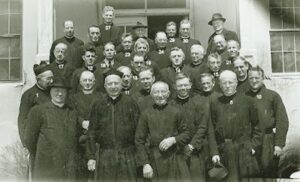Abuse of Indian children
Abuse of Indian children
Letters from St. Francis Indian Mission part II
By Wasuta Waste Win
Native Sun News Today Correspondent
PIERRE— Codified laws in the state of South Dakota are clear on “…offenses by and against minors…” and define childhood sexual abuse, as “any act committed by the defendant against the complainant who was less than eighteen years of age at the time of the act and which act would have been a violation of the state codified laws on sex offenses including rape.” The section defining childhood sexual abuse includes violation of prior laws regarded as sex offenses at the time the act the act was committed against a minor that would have constituted a felony.
In Eagleman vs. Saint Francis Mission in 2011, alleged sexual abuse took place at the Catholic boarding school on the Rosebud Reservation. Michael Shubeck, attorney for the case, uncovered letters dated from 1969 to 1973, in church records, that were proof of sexual abuse of minors at the school.
Shubeck who was interviewed at the time by South Dakota Public Broadcasting, said, “To find that evidence, it goes straight to the heart. It was appalling, and it’s really faith-shattering.” He continued, “The defendants (Catholic Church) have fought this as if the allegations weren’t real, and to discover that they had this in some dusty file is shocking as well.”
Shubeck referred to the letter by Church authorities on Brother Francis Chapman (See May 4 to May 10, 2022 issue) a pedophile who victimized little girls, some under the age of 7. In the case of Brother Chapman, the Catholic Church allowed him to remain at St. Francis until he died in 1990.
Also in the file was a letter written in 1994 by Father Bernard Fagan, a well-known local priest living among the people in St. Francis on the Rosebud Reservation. Father Fagan wrote the following to Rapid City Diocese officials: “While I was Director of St. Francis Mission in the late 1970’s, I began to experience sexual temptations in a way that had never occurred to me in more than thirty five previous years as a Jesuit. It began with viewing pornography, went on to masturbation, and even to sexual activity with Native American girls.” These letters are public record.
The court in Eagleman vs. Saint Francis Mission (2011) revealed that Father Fagan continued his behavior, engaging in “sexual activity with Native American girls between 1977 and 1980 in Rapid City where he “would pick up (girls) along the streets”. From 1982 to 1983, Father Fagan relapsed “with Indian girls who [he] picked up along the streets in the Winner area”.
Shubeck pointed out, “It explains something of the Jesuits reaction to those abuse allegations when they have someone in that position of authority (like Father Fagan) receiving those allegations and was in fact an abuser.” In 2011 Shubeck made a claim in the case that the church officials broke the law when they failed to report the alleged abuse to the proper authorities.
The statute of limitations in sex abuses, was added on to in 2010, when an attorney in Chamberlain, Steve Smith, argued in favor of protection for third party groups like the Catholic Church.
Today the abuse of or cruelty to minors is considered a Class 3 felony if the child is under seven years of age; otherwise, it is a Class 4 felony. A charge for abuse of or cruelty to a minor can be brought up according to South Dakota’s codified laws, “any time before the victim becomes age twenty-five”.
The wording for starting a civil action for damages resulting from childhood sexual abuse as defined in South Dakota codified law is worth examining today as some reservations, including Rosebud and Pine Ridge, continue to have educational institutions run by the Catholic Church.
The wording is as follows: “Any civil action based on intentional conduct brought by any person for recovery of damages for injury suffered as a result of childhood sexual abuse shall be commenced within three years of the act alleged to have caused the injury or condition, or three years of the time the victim discovered or reasonably should have discovered that the injury or condition was caused by the act, whichever period expires later. However, no person who has reached the age of forty years may recover damages from any person or entity other than the person who perpetrated the actual act of sexual abuse.”
In court proceedings, the date of discovery is important, and the codes specify that the victim does not need to state “which act in a series of continuing sexual abuse or exploitation incidents caused” injury, but “may compute the date of discovery from the date of discovery of the last act by the same perpetrator.”
A child is defined under state law as “any person under the age of eighteen years,” if state laws against abuse are limited, including the statute of limitations, then many, if not all, reservations in the state should move to protect children living on the reservations. Under consideration should be the closing and banning of any or all religious institutions engaged in educating children (K-12) on the reservations in South Dakota.
Part III Will take a close look at Eagleman vs. Saint Francis Mission from the stories and perspectives of the victims.
The post Abuse of Indian children first appeared on Native Sun News Today.

